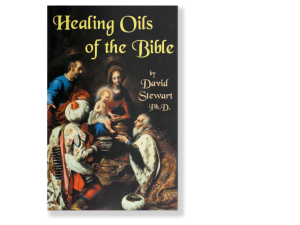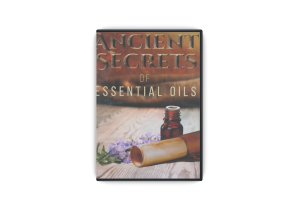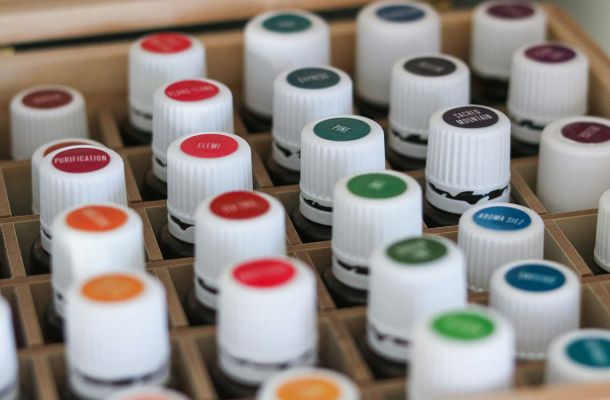Essential Oils Then and Now – Volume 1, Number 6
Please feel free to share this newsletter!

Raindrop Messenger
Official Newsletter of CARE
The Center for Aromatherapy Research and Education
12923 BCR 800, Marble Hill, Missouri USA 63764
(573) 238-4846
NOTE: The information in this newsletter is intended for education purposes only. It is not provided in order to diagnose, prescribe, or treat any disease, illness, or injured condition of the body or mind. Anyone suffering from any disease, illness, or injury should consult with a physician or other appropriate licensed health care professional.
Essential Oils Then and Now
By David Stewart, Ph.D., R.A.
Originally Posted July 2003
The Bible has more than 500 references to at least 33 species of essential oils and/or the herbs from which they are distilled. All of these scriptures are cited and discussed in the book, Healing Oils of the Bible. All of the oils used by
the people of Bible times are still used today, although not always for the same purposes. We shall discuss only three
here: Mint, Frankincense, and Myrrh.
MINT is mentioned in the Bible twice. In Matthew 23;23 and Luke 11:42 it is an item for tithing. Since the Jewish temples were places of daily animal sacrifice, one could imagine an unpleasant odor might result. But they had a solution. When you want to smell the fragrance of a plant, you naturally pinch off a leaf and crush it between your fingers which releases the aromatic oils. From antiquity through the time of Christ, the Jews applied this principle by scattering fresh mint leaves and stalks about the floors of the synagogue so that when people walked on them they were crushed, thus releasing the oil to the atmosphere and freshening the air. The temples consumed so much mint, and other aromatic herbs, that they were a matter for tithing to keep the necessary supply replenished. Other herbs containing aromatic oils used by Biblical people for the same purposes included marjoram, hyssop, and basil.
Today we would use aerosol sprays or electric powered oil diffusers to accomplish the same purpose. In more recent
times, mint oils have been found useful for many purposes. In addition to flavorings for gum, candy, and breath fresheners, mint oils have been found to have many healing properties. That peppermint oil is an aid to digestion has been known for centuries. This fact gave rise to the custom of taking “after dinner mints,” commonly served in restaurants.
In addition to support for digestion, Peppermint has also been found to be anticarcinogenic, expels worms, and pain-relieving. It has been effective in the treatment of asthma, candida, diarrhea, headaches, throat infections, and varicose veins.
FRANKINCENSE is mentioned in the Bible 22 times, the most familiar of which is regarding the gifts to the baby Jesus from the wise men. Mary and Joseph would have known, without any explanation from the wise men, that it was customary to anoint newborn sons of kings and priests with the oil of frankincense, which they no doubt did for their newborn child. Frankincense was considered a cure-all by the people of Biblical times and for those who could afford it, it was applied to cuts, bruises, and wounds of all kinds, as well as a inhaled and taken internally. Frankincense comes from a tree requiring a very unique desert climate. It grows only in North Africa and the Southern Arabian peninsula. The oil received by Jesus as a baby came from the same areas where we still get ours today.
Not only was frankincense used as a holy anointing oil, it was also one of the ingredients in the holy incense of the Hebrews (Exodus 30:34-37) burned perpetually in their tabernacles for more than a thousand years, through the time of Christ. Today one can still experience the fragrance of Frankincense in Catholic Churches where it has been customarily diffused for more than 2000 years.
While it has been used to treat every conceivable ill known to man for thousands of years, modern experience has shown that the fragrance of frankincense is an antidepressant and helps in overcoming stress and despair, as well as supporting the immune system. It has also been found helpful with allergies, insect and snake bites, bronchitis, cancer, pneumonia, diphtheria, headaches, hemorrhaging, high blood pressure, typhoid, and warts.
Frankincense has always been a popular fragrance for perfumes and lotions, from ancient times to the present. In fact, it is found in several modern products, including Youth Dew® (Estee Lauder) and the all-time best-selling after-shave lotion, Old Spice® (Shulton).
MYRRH is mentioned in the Bible 18 times. When Esther was being prepared to be the bride of the King, she receive a daily anointing of oil of myrrh for six months. (Esther 2:12). Of course, that’s not what most Christians think of when they think of myrrh. They think of the gifts of the wise men. (Matthew 2:11) Myrrh was an oil customarily applied to the umbilical cord of newborn babies. It’s antimicrobial action offered a protection from infection. The wise men would not have had to explain this to Mary and Joseph. It was common knowledge at that time. They would not have had to explain to Mary that the gift was also for her. Childbearing women of that time knew that if they applied myrrh to their tummies following labor that it would eventually remove stretch marks. In fact, in ancient times, for those who could afford it, oil of myrrh was inhaled and applied daily to the skin throughout pregnancy and was diffused during labor as its aromas induce a sense of peace and well-being.
Myrrh, like frankincense, is a universal oil, offering benefits for numerous complaints and conditions. Indicated for bronchitis, dysentery, hyperthyroidism, oral and vaginal thrush, ulcers, and viral hepatitis, it has also been found to benefit asthma, athlete’s foot, coughs, eczema, gingivitis, gum infections, hemorrhoids, mouth ulcers, ringworm, wounds, wrinkles, and chapped or cracked skin. It is widely used today in oral hygiene products.
Myrrh is what is known as “a fixing oil.” It extends the therapeutic action of any other oil with which it is combined. Biblical people knew this and included myrrh as a significant portion of all of their ointments. In fact, myrrh was such a universally common ingredient of healing ointments at the time of Christ, that the Greek word for “ointment” (muron) and the Greek word for “myrrh” (muron) were the same. Thus, when Jesus was anointed with the precious ointment (muron) of spikenard (Matthew 26:1; Mark 14:1-9; Luke 7:36-50; John 11:1-2, 12:1-8) he was also being anointed with
myrrh.
Myrrh has a very gentle scent and its fixing property is highly prized by perfumers. When combined with other oils, it makes the scent of those oils last longer without masking them. Some of the most delightful fragrances are also short-lived, evaporating rapidly. When one wears perfume or cologne, they want it to last for a whole evening or a day, and not be gone in minutes. Perfumers find myrrh to be the perfect “fixing oil” to extend more volatile fragrances. Modern feminine perfumes containing myrrh include: Fidji® (Laroche), Givenchy III® (Givenchy), Alliage® (Estee Lauder), Ravissa® (Maurer & Wirtz), and LeSport® (St. Laurent)—which also contains Sandalwood (aloes), another Biblical oil.
THE RAINDROP MESSENGER
Official Newsletter of CARE
The Center for Aromatherapy Research and Education
12923 BCR 800, Marble Hill, Missouri USA 63764
(573) 238-4846
NOTE: The information in this newsletter is intended for education purposes only. It is not provided in order to diagnose, prescribe, or treat any disease, illness, or injured condition of the body or mind. Anyone suffering from any disease, illness, or injury should consult with a physician or other appropriate licensed health care professional.
The Care Calendar
Topics covered in the Raindrop Messenger:
- 10 Reasons to Learn Raindrop
- 3 1/2 Day Intensive
- 3 Day Intensive
- Acid Reflux
- Advanced Bible Oils
- Advanced Chemistry of Essential Oils
- Advanced Emotional Release
- AFNOR
- Allergy Season
- Allopathy
- ALOES/SANDALWOOD
- and Emotional Release
- Annual CCI Summit
- Anointing
- Anointing with Oil & Laying on of Hands
- Applied Vitaflex
- Aroma Life
- Aromatherapist
- Aromatherapy
- Aromatherapy Certification
- Arthritis
- Believer
- BIBLE OILS
- Biblical Oils
- Birch Oil
- Black Widow
- Blue Chamomile
- Blue Spruce
- Body Systems
- cancer
- CARE Chemistry
- CARE Classes
- CARE Instructors
- CARE INTENSIVES
- CARE Seminars
- CARE Summit 2025
- CARE training
- Carvacrol
- CCI Certification
- CCI Summit
- CCI Summit 2024
- CEDARWOOD
- Center for Aromatherapy Research and Education
- Chakras
- Charging for Raindrop
- Chemistry
- Chemistry 1&2
- Chemistry of Essential Oils
- Chemistry of Essential Oils Made Simple
- Chemotypes
- cleanses
- Clover
- Connection
- Continuing Education Credit
- CYPRESS
- Dangers Of Prescription Drugs
- Detoxifiers
- Developing Gratitude
- DI GIZE
- DIAMOND
- Do All You Can
- Earthquakes
- Education
- Elderberry
- ELECTROMAGNETIC FIELD
- EM FIELD
- Emotional Release
- Emotional Release with Oils
- Energize
- ENZYMES
- Essential Oils
- ESSENTIAL OILS FOR INTUITIVE PURPOSES
- Essiac tea
- Exodus Supplement
- Feelings Kit
- Flu
- Focus
- Frankincense
- FREQUENCES
- Full CARE Intensive: Raindrop
- GALBANUM
- Garlic
- Gary Young
- German Chamomile
- Ginger
- Goals
- god's love
- Gold Frankincense Myrrh
- Grand Fir
- Grapefruit
- Growth
- Habits
- Harmonies Melodies & Symphonies with Essential Oils
- Heal Your Body
- Healing
- Healing Oils Of The Bible
- Helichrysum
- HERXING
- History of Anointing Oils
- Holy Anointing Oil
- Holy Incense
- Homeopathy
- Homeostatic Intelligence
- HYSSOP
- IASP
- Institute for Energy Wellness Studies
- Integrated Aromatic Science Practitioner
- Joy
- Juniper
- laughter
- Lavender
- Lee Stewart
- Legal
- lemongrass
- linen
- Liver
- Look Ahead.
- Love
- Lyme Disease
- Mind-Body Connection
- Mint
- Myrrh
- Myrtle Oil
- NAT
- Natural
- Natural Molecules
- Neuro-Auricular Technique
- never give up
- new age
- Ningxia
- Ningxia Red
- Non-Nutritive
- Nova Vita
- Ocotea Oil
- Onycha
- ORAC SCALE
- Oregano
- Oregano oil
- Overcoming Diabetes
- patchouly
- Peruvian Chocolate
- Pest Control
- pheromones
- phosphoric acid
- Photoxicity
- Pine
- POO-ROMATHERAPY
- Practitioner
- Preparation
- Protocel
- Pure Therapeutic Grade Essential Oil
- Quantum Physics
- Raindrop
- Raindrop and Vitaflex Techniques
- Raindrop certification
- Raindrop instructors
- Raindrop Technique
- Raindrop Technique Training
- Raindrop Training
- Raindrop Without a License
- RC Blend
- Relationship
- ringing in the ears
- Rose Essential Oil
- ROSE OF SHARON/CISTUS
- Rose Oil
- Safe Insect Repellants
- scar-b-gone
- Science Of Essential Oils Made Simple
- Sensitivities to Essential Oils
- sick building syndrome
- SPIKENARD
- Stay Positive
- staying healthy
- Success
- Supervisor Training
- Synthetic Compounds
- tansy
- Tea Tree
- The Blood Brain Barrier
- the Ecuador Clinic
- THE FIRST IMPRESSION TECHNIQUE
- the Mind-Body Connection
- THE PRAYER OF JABEZ
- The Quantum Connection
- THE SLEEP TECHNIQUE
- Therapeutic Grade
- Thieves Household Cleaner
- Thieves Oil
- Thyme
- Thyme Oil
- Tinnitus
- Transformation
- Transformation Oil Blend
- Twelve Questions to Ask Those Who Invite You to Join Another Company
- unresolved emotions
- valor blend
- Vita Flex
- Vitaflex
- Vitaflex and Raindrop
- water
- Wealth and Spirituality
- Wintergreen
- Wolfberries
- Ylang Ylang
- YLEO
- Young Living business
- Young Living Essential Oils
- Young Living Oils and Products




